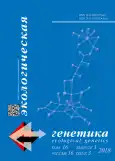Индукция повреждений ДНК в клетках костного мозга мышей при действии фарнезенов и 2,5-диметилпиразина
- Авторы: Даев Е.В.1, Мамонтова В.А.1, Глинин Т.С.1
-
Учреждения:
- Санкт-Петербургский государственный университет
- Выпуск: Том 16, № 3 (2018)
- Страницы: 47-54
- Раздел: Генетическая токсикология
- URL: https://journals.rcsi.science/ecolgenet/article/view/9022
- DOI: https://doi.org/10.17816/ecogen16347-54
- ID: 9022
Цитировать
Полный текст
Аннотация
В экспериментах на самцах домовой мыши показано, что феромоны 2,5-диметилпиразин и смесь α- и β-фарнезенов индуцируют повреждения генетического материала в клетках костного мозга реципиентов. Данные, полученные методом кометного электрофореза, подтверждены цитогенетическим анализом делящихся клеток на стадии ана-телофазы. Одновременное воздействие хемосигналами не приводит к усилению эффекта.
Ключевые слова
Полный текст
Открыть статью на сайте журналаОб авторах
Евгений Владиславович Даев
Санкт-Петербургский государственный университет
Автор, ответственный за переписку.
Email: mouse_gene@mail.ru
ORCID iD: 0000-0003-2036-6790
SPIN-код: 8926-6034
Scopus Author ID: 6701779129
ResearcherId: D-1165-2013
д-р биол. наук, профессор, кафед ра генетики и биотехнологии
Россия, 199034, г. Санкт-Петербург, Университетская наб., д.7/9
Виктория Андреевна Мамонтова
Санкт-Петербургский государственный университет
Email: vicktory.shubina@gmail.com
студент, кафедра генетики и биотехнологии
Россия, 199034, г. Санкт-Петербург, Университетская наб., д.7/9Тимофей Сергеевич Глинин
Санкт-Петербургский государственный университет
Email: t.glinin@gmail.com
аспирант, кафедра генетики и био технологии
Россия, 199034, г. Санкт-Петербург, Университетская наб., д.7/9Список литературы
- Dulac C, Torello AT. Molecular detection of pheromone signals in mammals: from genes to behaviour. Nat Rev Neurosci. 2003;4(7):551-562. doi: 10.1038/nrn1140.
- Asaba A, Hattori T, Mogi K, Kikusui T. Sexual attractiveness of male chemicals and vocalizations in mice. Front Neurosci. 2014;8:231. doi: 10.3389/fnins.2014.00231.
- Harvey S, Jemiolo B, Novotny M. Pattern of volatile compounds in dominant and subordinate male mouse urine. J Chem Ecol. 1989;15(7):2061-2072. doi: 10.1007/BF01207438.
- Novotny M, Harvey S, Jemiolo B. Chemistry of male dominance in the house mouse, Mus domesticus. Experientia. 1990;46(1):109-113. doi: 10.1007/bf01955433.
- Morgan C. Melanocortin-5 Receptor Deficiency Reduces a Pheromonal Signal for Aggression in Male Mice. Chem Senses. 2004;29(2):111-115. doi: 10.1093/chemse/bjh011.
- Jemiolo B, Andreolini F, Xie T-M, et al. Puberty-affecting synthetic analogs of urinary chemosignals in the house mouse, Mus domesticus. Physiol Behav. 1989;46(2):293-298. doi: 10.1016/0031-9384(89)90270-9.
- Даев Е.В., Суринов Б.П., Дукельская А.В. Влияние стресса на хемосигнализацию у лабораторных мышей линии CBA и C57BI/6 // Экологическая генетика. – 2007. – Т. 5. – № 2. – C. 37–43. [Daev EV, Surinov BP, Dukelskaya AV. Chemosignaling in CBA and C57Bl/6 mouse strains is modified by stress. Ecological Genetics. 2007;5(2):37-43. (In Russ.)]. doi: 10.17816/ecogen5237-43.
- Даев Е.В. Генетические эффекты ольфакторного стресса: исследования на домовой мыши. — Саарбрюккен: Lambert Academic Publishing, 2011. [Daev EV. Geneticheskie effekty ol’faktornogo stressa: issledovaniya na domovoy myshi. Saarbrücken: Lambert Academic Publishing; 2011. (In Russ.)]
- Сирота Н.П., Кузнецова Е.А. Применение метода «комета тест» в радиобиологических исследованиях // Радиационная биология. Радиоэкология. – 2010. – Т. 50. – № 3. – С. 329–339. [Sirota NP, Kuznetsova EA. The Comet Assay Application in Radiobiological Investigations. Radiation biology, radioecology. 2010;50(3):329-339. (In Russ.)]
- Sasaki YF, Sekihashi K, Izumiyama F, et al. The comet assay with multiple mouse organs: comparison of comet assay results and carcinogenicity with 208 chemicals selected from the IARC monographs and U.S. NTP Carcinogenicity Database. Crit Rev Toxicol. 2000;30(6):629-799. doi: 10.1080/10408440008951123.
- Daev EV, Kazarova VE, Vyborova AM, Dukel’skaya AV. Effects of “Pheromone-Like” pyrazine-containing compounds on stability of genetic apparatus in bone marrow cells of the male house mouse Mus musculus L. J Evol Biochem Physiol. 2009;45(5):589-595. doi: 10.1134/s0022093009050053.
- Daev EV, Petrova MV, Onopa LS, et al. DNA damage in bone marrow cells of mouse males in vivo after exposure to the pheromone: Comet assay. Russian Journal of Genetics. 2017;53(10):1105-1112. doi: 10.1134/s1022795417100027.
- Costa EV, Menezes LR, Rocha SL, et al. Antitumor Properties of the leaf essential oil of Zornia brasiliensis. Planta Med. 2015;81(7):563-567. doi: 10.1055/s-0035-1545842.
- Phutdhawong W, Donchai A, Korth J, et al. The components and anticancer activity of the volatile oil fromStreblus asper. Flavour Fragr J. 2004;19(5):445-447. doi: 10.1002/ffj.1342.
- Can OD, Demir Ozkay U, Kiyan HT, Demirci B. Psychopharmacological profile of Chamomile (Matricaria recutita L.) essential oil in mice. Phytomedicine. 2012;19(3-4):306-310. doi: 10.1016/j.phymed.2011.10.001.
- Çelik K, Toğar B, Türkez H, Taşpinar N. In vitro cytotoxic, genotoxic, and oxidative effects of acyclic sesquiterpene farnesene. Turk J Biol.. 2014;38:253-259. doi: 10.3906/biy-1309-55.
- Suckling DM, Stringer LD, Bunn B, et al. Trail pheromone disruption of red imported fire ant. J Chem Ecol. 2010;36(7):744-750. doi: 10.1007/s10886-010-9810-6.
- Verheggen FJ, Diez L, Sablon L, et al. Aphid alarm pheromone as a cue for ants to locate aphid partners. PLoS One. 2012;7(8): e41841. doi: 10.1371/journal.pone.0041841.
- Sasaki T, Holldobler B, Millar JG, Pratt SC. A context-dependent alarm signal in the ant Temnothorax rugatulus. J Exp Biol. 2014;217(Pt 18):3229-3236. doi: 10.1242/jeb.106849.
- Park D, Maga JA. Identification of key volatiles responsible for odour quality differences in popped popcorn of selected hybrids. Food Chem. 2006;99(3):538-545. doi: 10.1016/j.foodchem.2005.08.019.
- Paraskevopoulou A, Chrysanthou A, Koutidou M. Characterisation of volatile compounds of lupin protein isolate-enriched wheat flour bread. Food Res Int. 2012;48(2):568-77. doi: 10.1016/j.foodres.2012.05.028.
- Brown RE, Macdonald DW. Social odours in mammals. Oxford: Oxford University Press; 1985.
- J Vandenbergh, editor. Pheromones and Reproduction in Mammals. 1st ed. London: Elsevier; 1983.
- Jemiolo B, Xie T-M, Novotny M. Urine marking in male mice: Responses to natural and synthetic chemosignals. Physiol Behav. 1992;52(3):521-526. doi: 10.1016/0031-9384(92)90341-x.
- Novotny M, Jemiolo B, Harvey S, et al. Adrenal-mediated endogenous metabolites inhibit puberty in female mice. Science. 1986;231(4739):722-725. doi: 10.1126/science.3945805.
- Jemiolo B, Novotny M. Inhibition of sexual maturation in juvenile female and male mice by a chemosignal of female origin. Physiol Behav. 1994;55(3):519-522. doi: 10.1016/0031-9384(94)90110-4.
- Tzapigina R, Aref’ev A, Sverdlova O, Daev E. Pheromonal regulation hypothesis of the space-genetic structure of the house mouse (Mus musculus L.) populations. In: Proceedings of the World Congress of Landscape Ecology, IALE; 1991; Ottawa, Canada. Ottawa: Carleton University; 1991. p. 84.
Дополнительные файлы








